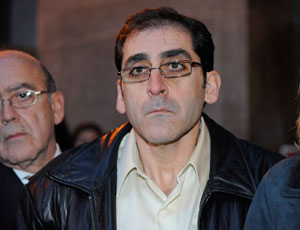The attorney for the embattled crane rigger accused of causing the deadly 2008 crane collapse in Midtown Manhattan said that “incompetence at the highest levels of city government” killed seven in the tragedy, rather than the “recklessness” prosecutors alleged against his client.

Even though the rigger, William Rapetti declined a jury, opening statements in his manslaughter trial were marked by theatrics, props, emotional appeals and slideshows in front of a steely Justice Roger Hayes.
Assistant district attorney Sean Sullivan started by waving a yellow, polyester band representing the sling that he said Rapetti and his company Rapetti Rigging Services, installed “carelessly” and “recklessly” on the day the 200-ft crane tumbled from a rising residential tower on East 51st Street.
Sullivan claimed that regulations called for the crane to be supported by eight bands, but he said Rapetti used only four that included sun-beaten, torn and damaged ones improperly tied to edges and corners.
Photographic evidence came out early as the assistant DA flashed pictures onto a screen showing the slings tied at an angle, which he said contradicted the instructions printed on the back of every band.
As he shifted to an emotional description of the surviving family members, personal backgrounds and fatal injuries of the seven who died, Rapetti’s three daughters seated in the front row broke out into sobs and had to be escorted out of the courtroom.
Sullivan promised the prosecution’s case would include the “frantic” 911 call of a man trapped under the rubble for four hours; doctors describing “devastating, mortal injuries” and “gripping, first hand accounts of when the slings failed.”
Rapetti’s attorney, Arthur Aidala, said that the slings were not the problem, and the crane itself was never bolted to the ground because the developers were trying to speed up construction to profit on the housing boom.
Aidala said that ground was excavated prematurely so that Con Edison could install electricity, and the building could start renting units sooner. But he said the hole in the ground left nothing for the crane to bolt down to, claiming it was supported merely “by friction.”
The city’s Department of Buildings refused to approve the design until engineer Peter Stroh wrote letters to convince them, Aidala claimed.
“Before March 15, this crane was already falling down,” Aidala said. “They were walking into an ambush that day.”
Portraying his client as a “blue collar worker” besieged by “pencil sharpened” bureaucrats, Aidala said that the city called on Rapetti as a rescue worker after Sept. 11, 2001, and now were using him as a "scapegoat" for systemic corruption.
Mocking the prosecution’s video simulations of the crash as “Disney/Pixar” creations by people in “white lab coats,” he claimed that Rapetti tested the broken sling theory “the Brooklyn way,” by taking crane workers to a secluded lot to run their own series of tests.
He said that this experiment found that four slings gave enough support for a crane of that size, and he added that the crane continued to stand even after the workers cut one entirely and damaged the others.
Aidala claimed that by opening his remarks with the crane collapse on March 15, 2008, prosecutor Sullivan was asking the judge to measure a book by its final pages.
“We ask the court to read the whole book,” he said.

Post a comment to this article
Report Abusive Comment